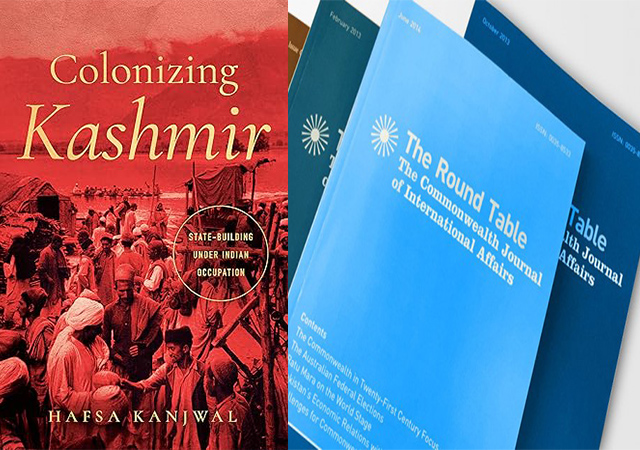
[This is an excerpt from an article in The Round Table: The Commonwealth Journal of International Affairs.]
The political dispute over the territory of Jammu and Kashmir is an intricate problem confronting modern South Asian leadership. Much of the scholarship has analysed the Kashmir conflict through the lenses of India–Pakistan relations. Colonizing Kashmir, breaking this tradition, aims to examine local regimes, which, according to Kanjwal, favoured ‘particular forms of state-building and governance’, thus enabling Kashmir’s accession to India (p. 2). Focusing on Kashmir’s second Prime Minister Bakshi Ghulam Mohammad, who ‘was brought to power’ through a political coup in 1953 against popular Kashmiri politician Sheikh Mohammad Abdullah, Kanjwal delineates how the Bakshi regime would bind the people and government in new ways, which ultimately paved the way for expanding the capacity of state-building apparatus (p. 29).
Colonizing Kashmir consists of seven chapters, excluding an introduction and conclusion. In Chapter one, Kanjwal examines the life of Bakshi Ghulam Mohammad, who grew up under the Dogra authoritarianism, when the majority of the ‘population of the state were suffering economically, politically and socially’ (p. 36). All these dire conditions led to anti-Dogra agitations and Bakshi’s involvement in these elevated him to become a close confidante of Sheikh Mohammad Abdullah. Being a working member of the party gave him first-hand experience of how to deal with the everyday life of people and that played ‘an important role in shaping his economic development policies – and indeed, the politics of life’ (p. 43).
Constitutional coup ends Kashmir’s historic rights
Indian General Elections and the State of Jammu and Kashmir
Commonwealth journalists look at the future of Kashmir
The second chapter discusses how the Bakshi regime used media to present a narrative of normalisation and progress in Kashmir. Kanjwal argues the target of pacifying the international and national audiences was achieved through the Indian Ministry of Information and Broadcasting (MIB) and the State government’s Department of Information. They together took over the control of media outlets and started propagating ‘the politics of life to position Kashmir as heaven of progress and development and to project the normalisation’ (p. 71). Thus, international delegations from various countries were invited to report and ‘portray Kashmir as benefiting from accession to India and rejecting the need for a plebiscite’ (p. 85).
The various developmental policies adopted by the Bakshi government set Kashmir into a new relationship with New Delhi. After assuming the role of state premier, Bakshi broadcast his policy speech on Radio Kashmir, criticising Sheikh Abdullah for not being a leader of development. Bakshi emphasised ‘economic development as a panacea to overcome the state’s political problems’ (129). For Kanjwal, however, the five-year plans for loans to the state exchequer, and the highly subsidised economy, created the systematic dependence of Kashmir on the centre. Meanwhile, the bureaucratic nepotism endorsed by Bakshi for manufacturing his legitimacy resulted in widespread corruption. And this, according to Kanjwal, was skilfully used by India as the ‘discourse on corruption diverted public attention to issues of good governance and away from the underlying issues of the nature of political sovereignty’ (p. 156).
Cultural appropriation forms the theme of chapter six. Kanjwal argues that in 1956 the Bakshi government hosted the first ever Jashn-e-Kashmir (Festival of Kashmir), which was aimed at ‘breaking from the tension and politics … that followed the change-over in August 1953’ (p. 203). This was followed by a series of cultural developments, culminating in the establishment of a Cultural Academy to promote Kashmiri cultural nationalism that was ‘in tandem with – and not threat to – Indian nationalism’ (204). Culture as an ideological apparatus of state, Kanjwal argues, was thus used for ‘the broader goals of state building’ and more importantly to ‘project the normalcy to observers outside Kashmir’ (p. 203).
Amin Kamil’s story, ‘The Shadow and the Substance’, which is about a person who is spying on people for the State, but ultimately wakes up to the knowledge that even he was not immune to the radar of surveillance, forms the background of the last chapter. Kanjwal argues that the State applied ‘sophisticated, organised widespread, and penetrating security and surveillance grid that criminalised political beliefs and aspirations that did not subscribe to that of the Kashmir and Indian governments’ (p. 235). Kanjwal further argues that suppression of political dissent was not new during the Bakshi rule. But its precedents were set by his predecessors. Kanjwal hypothetically argues that it was not State repression alone that led to silencing of the dissent but the ‘lack of ideological coherence … [given] many of the [its] leaders operated within the same frame of reference and background as those who were officially in power’ (p. 237).
Mohammad Asif Najar & Muneeb Yousuf are with Jamia Millia Islamia, New Delhi.
Colonizing Kashmir: State-building under Indian occupation by Hafsa Kanjwal, Stanford, Stanford University Press, 2023.



